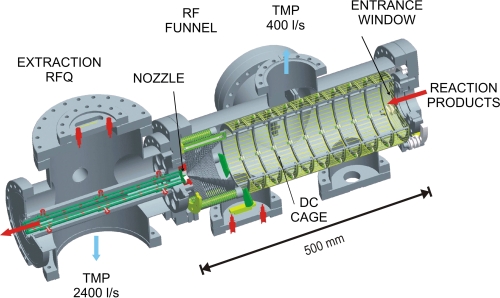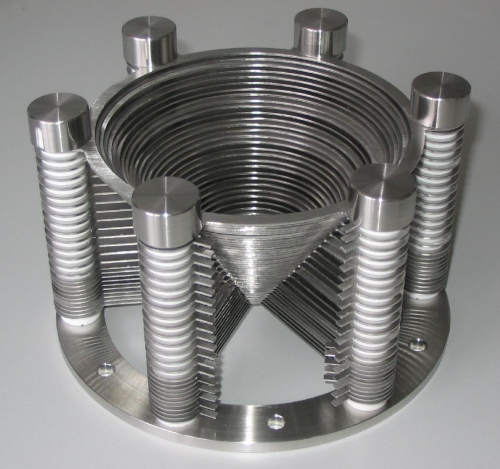Buffer gas Stopping Cell
MLL-IonCatcher
As a prerequisite of online mass measurements with MLLTRAP and as a continuation of the development of ion-catcher devices at the Maier-Leibnitz Laboratory in Garching, the MLL IonCatcher gas-cell setup has been installed. Its purpose is to stop incoming fusion-reaction products within a helium buffer gas and to extract them as singly- or doubly-charged ions in order to provide them for experiments. The design is based on the SHIPTRAP gas cell [1] and its extraction radiofrequency quadrupole (RFQ), however, it implies a few modifications. As the MLLTRAP stopping chamber is designed for a longitudinal injection and extraction of reaction products, the dimensions differ significantly from the design parameters of the SHIPTRAP cell.

View into the MLL-IonCatcher and its electrode structures.
Ions enter the He-gas volume through a thin, metallic entrance window foil (Ti, 3 mum) and get stopped in about 50 – 100 mbar ultra-pure helium gas. They are guided by electric DC- and RF fields towards an extraction nozzle (0.6 mm diameter), where they are dragged out of the stopping cell. Forming a supersonic gas jet, the ions and the carrier gas enter the acceptance of the subsequent extraction RFQ, where the carrier gas is pumped away and the phase-space cooling is applied to improve the ion beam emittance. One of the main differences of the MLLTRAP IonCatcher compared to the SHIPTRAP cell is the positioning of the entrance window along the ions’ extraction axis and the modified dimensions of the stopping volume. Since the ions enter the cell on its longitudinal symmetry axis, the radius of the cell is reduced from 180 mm to 150 mm compared to SHIPTRAP, while the requested flexibility in stopping ranges leads to an increase of the gas-cell length from 330 mm to 500 mm. The decrease in diameter demands a modified RF-funnel geometry, leading to a smaller aperture angle with the advantage of lower RF amplitudes required. In order to minimize ion losses due to neutralization or molecule formation with gas impurities, special attention was paid on the purity of the system by using only bakeable stainless steel and ceramic components.

Photo of the IonCatcher RF-funnel structure.
In order to improve the pumping conditions, the new extraction chamber is larger compared to the previous one - offering a better pumping cross section with a larger flange diameter and an upgrade to a 2400 l/s turbomolecular pump. The resulting increase in size of the extraction chamber is compensated by an increased length of the extraction RFQ from previously 18 cm to 30 cm, whilst the number of segments (12) is kept constant. Compared to the SHIPTRAP RFQ the new version is based on the same structure and has the same aperture and rod diameter. In order to improve the mechanical stability of the rods, a third attachment point to the support structure is added. Presently a maximum overall efficiency (stopping + extraction + RFQ transmission) of up to 16% has been achieved [2].
References:
[1] J. Neumayr et al. Nucl. Instr. and Meth. B 244 (2006) 489.
http://dx.doi.org/10.1016/j.nimb.2005.10.017
[2] J. Neumayr et al., Rev. of Scient. Instr. 77 (2006) 065109.
http://dx.doi.org/10.1063/1.2213154

